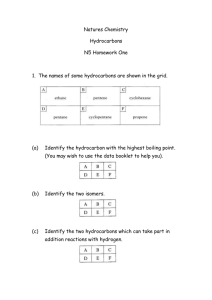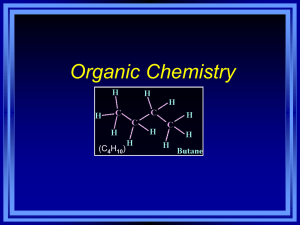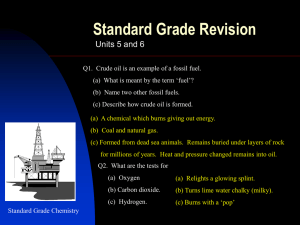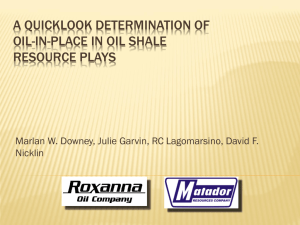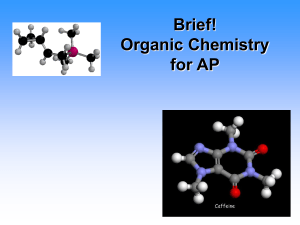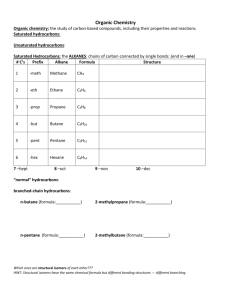Naming, Drawing and Constructing Molecular Models of
advertisement
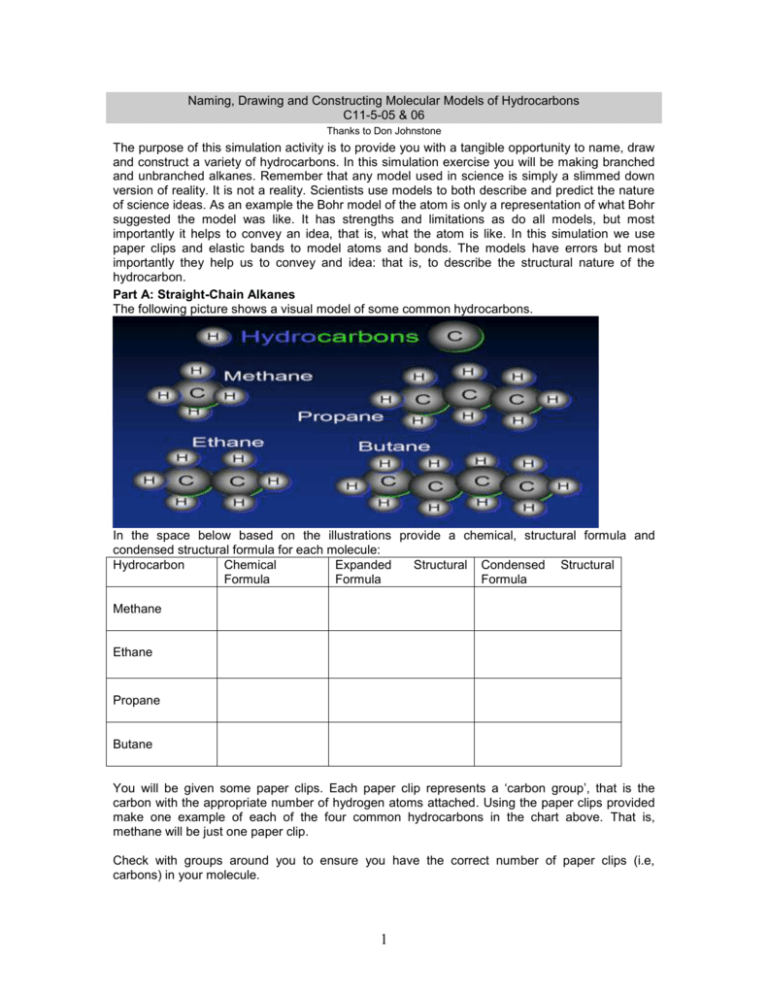
Naming, Drawing and Constructing Molecular Models of Hydrocarbons C11-5-05 & 06 Thanks to Don Johnstone The purpose of this simulation activity is to provide you with a tangible opportunity to name, draw and construct a variety of hydrocarbons. In this simulation exercise you will be making branched and unbranched alkanes. Remember that any model used in science is simply a slimmed down version of reality. It is not a reality. Scientists use models to both describe and predict the nature of science ideas. As an example the Bohr model of the atom is only a representation of what Bohr suggested the model was like. It has strengths and limitations as do all models, but most importantly it helps to convey an idea, that is, what the atom is like. In this simulation we use paper clips and elastic bands to model atoms and bonds. The models have errors but most importantly they help us to convey and idea: that is, to describe the structural nature of the hydrocarbon. Part A: Straight-Chain Alkanes The following picture shows a visual model of some common hydrocarbons. In the space below based on the illustrations provide a chemical, structural formula and condensed structural formula for each molecule: Hydrocarbon Chemical Expanded Structural Condensed Structural Formula Formula Formula Methane Ethane Propane Butane You will be given some paper clips. Each paper clip represents a ‘carbon group’, that is the carbon with the appropriate number of hydrogen atoms attached. Using the paper clips provided make one example of each of the four common hydrocarbons in the chart above. That is, methane will be just one paper clip. Check with groups around you to ensure you have the correct number of paper clips (i.e, carbons) in your molecule. 1 Compare your paper clip molecules to the formula in your chart and the illustrations. What does each paper clip link represent? What effect does each paper link have in terms of the number of hydrogen atoms that each carbon has? Compare the end and second to end carbons to answer this question. Explain why each link or bond reduces the number of hydrogen atoms on each carbon atom. Complete this chart in the same manner you did the first four alkanes: Hydrocarbon Chemical Formula Expanded Structural Formula Condensed Structural Formula Pentane Hexane Heptane Octane Nonane Decane Consider the names and structures of these first straight chain hydrocarbons. Which have you heard of? What are these ones you are familiar with used for? These hydrocarbons are all ‘saturated’ hydrocarbons. What does this term mean? Note the relationship between the number of carbons and the number of hydrogens. Do you see a trend? What is the general algebraic formula for these hydrocarbons? Look at these molecules below. Are they alkanes? Why or why not? Give the chemical formula for each? You might notice there is a trend in the state of alkanes as the number of carbons increases. What trend do you notice? 2 Part B: Branched-Chain Hydrocarbons The illustration below is of a hydrocarbon. Draw this molecule in the form of aexpanded structural formula. Draw it in its condensed structural formula. Finally, what is it’s chemical formula? What straight-chain hydrocarbon from the first page does it have the same formula as? Note that this molecule has the same chemical formula as butane but has a different structural formula. Molecules that have the same chemical formula, but different structural formula are called structural isomers. Structural isomers typically have different physical and chemical properties. This molecule is not as flammable as butane as is used as a propellant in aerosol sprays and as a coolant in refrigeration systems, mainly because it does not have the detrimental effect on the ozone layer that the refrigerant Freon does. The molecule above is called 2-methyl propane. Try to deduce why it is called this. Can you draw what you think 2-methyl butane would look like? At this stage your teacher will assist you in developing some rules for naming branched chain hydrocarbons. These will be listed in the space below. 3 Using your paper clips make a straight chain molecule of pentane. Again, provide the chemical, expanded structural and condensed structural formula below. Now, using the paper clips model, make as many isomers of this straight chain isomer as you can. Draw and name as many examples as you can. How many are there in total? 1. 2. 3. 4. Compare your examples to those illustrated below: You may wish to check how the properties and uses of the isomers of pentane differ. Continue by making a straight chain of hexane with the paper clips. Now, construct and name as many isomers of hexane as you can. Draw and name these in the space below. There may be more than the numbers indicate. 1. 2. 3. 4. 4 Part C: Testing Your Understanding: Using the paper clips quietly make a straight-chain or branched saturated hydrocarbon that has a maximum of 10 carbons (paper clips). Your classmates will be doing the same. Don’t let them know the name of your hydrocarbon. Provide the chemical formula, the hydrocarbon’s name and draw its structural formula in the space below. Once you have done your own meet up with at least 8 other classmates and write the name and structural formula of their compound in your chart. They will tell you if your name, chemical formula and structural formula are correct. Classmate’s Name Chemical Formula Name Hydrocarbon of Structural Formula Correct? Summary: The purpose of this simulation activity has been to provide you with a tangible opportunity to name, draw and construct a variety of hydrocarbons. In this simulation exercise you made and named branched and unbranched alkanes. Remember that any model used in science is simply a slimmed down version of reality. It is not a reality. Scientists use models to both describe and predict the nature of science ideas. As an example the Bohr model of the atom is only a representation of what Bohr suggested the model was like. It has strengths and limitations as do all models, but most importantly it helps to convey an idea, that is, what the atom is like. In this simulation we use paper clips and elastic bands to model atoms and bonds. The models have errors but most importantly they help us to convey and idea: that is, to describe the structural nature of the hydrocarbon. You have also learned that there are structural isomers of the same compound. These isomers have similar chemical formulae but different structures, properties and uses. You have also learned that there are many ways of representing the structures of hydrocarbons. Again, they all are just representations of reality. 5 6


